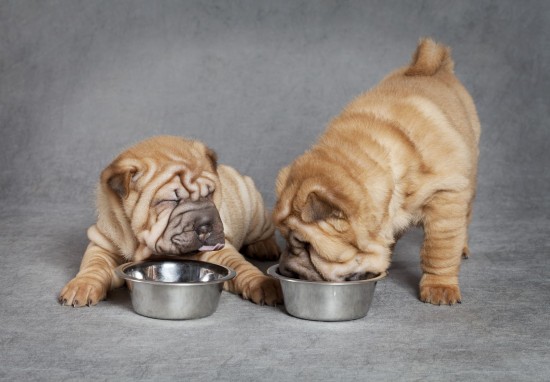

Different breeders have their own timetable for weaning, but this generally commences when the puppies are about 3 weeks old. However, if the litter is unusually large then weaning can begin a little earlier in order to prevent the bitch from becoming overly fatigued.
Don’t add vitamins and minerals to an already complete commercial puppy food unless the vet has diagnosed any deficiency. This can upset the calcium to phosphorous ratio and result in skeletal problems such as osteochondrosis and osteochondritis dissecans (OCD).
When the puppies are very young, commercial dry puppy food should be soaked for about ½ hr prior to serving to soften it. Mix it well to form a porridge-like consistency, and ensure that sufficient water is added to achieve a nice consistency for lapping. A blender can be used for a very smooth texture. Puppies prefer their food at body temperature, so make sure it is neither too hot nor too cold. As the puppies get older, you can gradually add less water for a firmer consistency. Initially, you may need to encourage the individual puppies to take the food by placing some on the end of your finger and allowing them to either lick or suck.
There are different schools of thought as to whether individual feeding or group feeding is better. The best choice depends on the litter. If there are any concerns that some pups are gorging and others are not getting enough food, individual feeding is better as intake can be more accurately monitored. Feeding the group from a shared tray does encourage some healthy competition and is a good idea for the initial feeds since the more reticent pups may take their lead from the bolder ones, and this may help encourage them to accept the puppy food.
Be prepared for lots of mess! The puppies will play with their food and even roll in it. Just like babies, they may well find meal-times a lot of fun. Paddling through the food is not a bad thing because the pups will lick the food from their feet and it can help reluctant eaters to make the transition from milk to food.
Feed little and often, and remember that puppies have very small stomachs. Four meals per day are the norm when weaning. Don’t be tempted to over-feed. This can result in diarrhoea. Over nutrition also increases the risk of developmental orthopaedic conditions.The bitch will usually be happy to finish up any uneaten food. Don’t leave surplus food out for too long as it may ferment, attract flies or act as a substrate for bacterial growth.
Some litters are harder to wean than others. If you are having difficulty getting the puppies to accept food over milk, make sure they are hungry before offering them food. They are not likely to want to eat if they have already got a belly full of milk. Taking the bitch out before meal-times can help because this limits access to her. If you want to reduce the amount of milk the bitch is producing, you will need to reduce her food.
Make sure you are able to identify all of the puppies so that you can monitor progress. Special little coloured collars are available for this purpose. Keep a record of the feeding volumes and the puppies’ weights so that you can quickly identify any problems.
When introducing a water bowl (usually when the puppies are around 4 weeks of age) make sure it is heavy so that it can’t be over-turned, and that it is of a suitable design and size that won’t allow the pups to fall into it and drown.
When the puppies are mobile and weaning is underway and going well, it is a good idea to create a defined nest for sleeping within the whelping box, and another zone with newspaper or training pads for toileting. There will of course be times when the pups do soil the bed, but they don’t like sleeping in dirty areas. This will make house training easier. Another hygiene aspect to keep in mind, is that once the puppies are eating, she won’t clean up after them. This therefore becomes your job, so be prepared with plenty of wipes and bags for soiled items.
Copyright © 2005-2016 Pet Information All Rights Reserved
Contact us: www162date@outlook.com